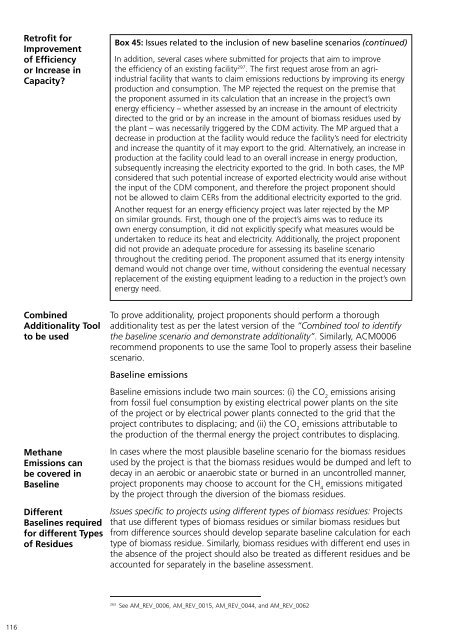Understanding CDM Methodologies - SuSanA
Understanding CDM Methodologies - SuSanA
Understanding CDM Methodologies - SuSanA
Create successful ePaper yourself
Turn your PDF publications into a flip-book with our unique Google optimized e-Paper software.
Retrofit for<br />
Improvement<br />
of Efficiency<br />
or Increase in<br />
Capacity?<br />
Box 45: Issues related to the inclusion of new baseline scenarios (continued)<br />
In addition, several cases where submitted for projects that aim to improve<br />
the efficiency of an existing facility 297 . The first request arose from an agriindustrial<br />
facility that wants to claim emissions reductions by improving its energy<br />
production and consumption. The MP rejected the request on the premise that<br />
the proponent assumed in its calculation that an increase in the project’s own<br />
energy efficiency – whether assessed by an increase in the amount of electricity<br />
directed to the grid or by an increase in the amount of biomass residues used by<br />
the plant – was necessarily triggered by the <strong>CDM</strong> activity. The MP argued that a<br />
decrease in production at the facility would reduce the facility’s need for electricity<br />
and increase the quantity of it may export to the grid. Alternatively, an increase in<br />
production at the facility could lead to an overall increase in energy production,<br />
subsequently increasing the electricity exported to the grid. In both cases, the MP<br />
considered that such potential increase of exported electricity would arise without<br />
the input of the <strong>CDM</strong> component, and therefore the project proponent should<br />
not be allowed to claim CERs from the additional electricity exported to the grid.<br />
Another request for an energy efficiency project was later rejected by the MP<br />
on similar grounds. First, though one of the project’s aims was to reduce its<br />
own energy consumption, it did not explicitly specify what measures would be<br />
undertaken to reduce its heat and electricity. Additionally, the project proponent<br />
did not provide an adequate procedure for assessing its baseline scenario<br />
throughout the crediting period. The proponent assumed that its energy intensity<br />
demand would not change over time, without considering the eventual necessary<br />
replacement of the existing equipment leading to a reduction in the project’s own<br />
energy need.<br />
Combined<br />
Additionality Tool<br />
to be used<br />
263<br />
To prove additionality, project proponents should perform a thorough<br />
additionality test as per the latest version of the “Combined tool to identify<br />
the baseline scenario and demonstrate additionality”. Similarly, ACM0006<br />
recommend proponents to use the same Tool to properly assess their baseline<br />
scenario.<br />
Baseline emissions<br />
Baseline emissions include two main sources: (i) the CO 2<br />
emissions arising<br />
from fossil fuel consumption by existing electrical power plants on the site<br />
of the project or by electrical power plants connected to the grid that the<br />
project contributes to displacing; and (ii) the CO 2<br />
emissions attributable to<br />
the production of the thermal energy the project contributes to displacing.<br />
Methane<br />
Emissions can<br />
be covered in<br />
Baseline<br />
Different<br />
Baselines required<br />
for different Types<br />
of Residues<br />
In cases where the most plausible baseline scenario for the biomass residues<br />
used by the project is that the biomass residues would be dumped and left to<br />
decay in an aerobic or anaerobic state or burned in an uncontrolled manner,<br />
project proponents may choose to account for the CH 4<br />
emissions mitigated<br />
by the project through the diversion of the biomass residues.<br />
Issues specific to projects using different types of biomass residues: Projects<br />
that use different types of biomass residues or similar biomass residues but<br />
from difference sources should develop separate baseline calculation for each<br />
type of biomass residue. Similarly, biomass residues with different end uses in<br />
the absence of the project should also be treated as different residues and be<br />
accounted for separately in the baseline assessment.<br />
263<br />
See AM_REV_0006, AM_REV_0015, AM_REV_0044, and AM_REV_0062<br />
116

















